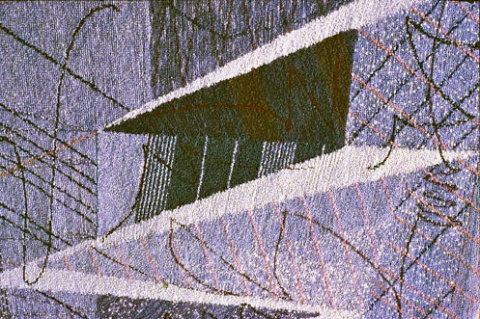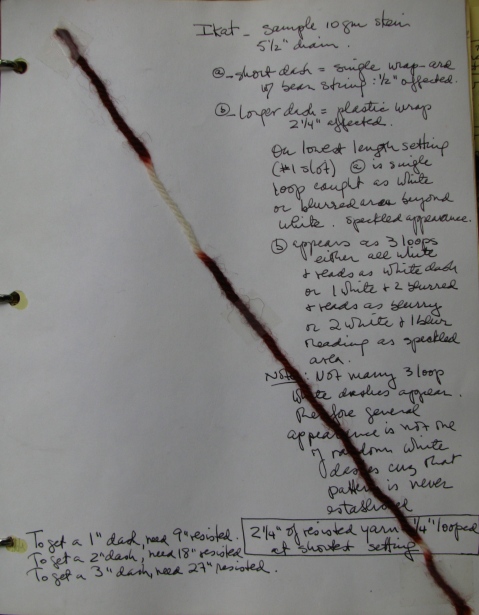Ikat dyeing aka space dyeing
February 24, 2012
Ikat dyeing is an Indonesian resist method of dyeing yarn or threads so that when woven into cloth the resist sections produce patterns or designs. Simply put, resist dyeing involves applying a resist element to specific sections of the yarn–you bind sections with plastic tape or bean string–so that those areas cannot absorb dye during the dyeing process. The bound sections retain the color the binding element covers, which is generally a lighter value than the rest of the skein. A single wrap around/tie with plastic tape produces a 2-1/4″ section; a single wrap around/tie with bean string affects 1/2.” In tufting, the length of the loop affects the length of the resist dots and dashes visible on the surface of the tufted piece
The preparation of the wool skeins for ikat dyeing is labor intensive, as is the dyeing process for it usually involves more than one dye session. The yarn preparation involves winding and weighing the skeins, washing and drying them, and then binding sections to resist the dye. If you’re after dots/dashes of various colors or values, that involves more rounds of tying and dyeing.
For tufting, I want random or regularly spaced dots or dashes that the resist can produce. So I use the most elementary form of ikat in that I do not resist sections of yarn to produce definite patterns or designs as for ikat woven cloth. I bind the yarn either in a controlled (evenly spaced and of even length), or random manner (haphazard spacing and length for an irregular, scatter-shot effect) so’s to get dashes or dots of color (the resist sections).

"Peruvian Lattice," detail, 1988
In “Peruvian Lattice,” I use ikated yarn that has gone through one dye session to produce white dots and dashes. As I fill a shape with an ikated yarn, I cannot control where the dots will appear. Sometimes I get lucky and get a moire effect which becomes random patterning. In this piece, the ikated areas read as ground to the solid colored shapes giving more spatial depth to the composition than it otherwise would have.

"Dance of the Crane," detail, © 1985
For the white dots in “Dance of the Crane,” I used a bean string resist wound round once and tied–irregularly spaced. Some gray yarn I first dyed using part of my “Martha’s Gray” formula, then I wrapped/tied tape around 2″ randomly spaced sections and put it through a second dye session using the remaining ingredients to the formula. The dark gray triangle at top/center was done this way.
I pulled some yarn sample sheets from my “Constrictor Constrictor” folder to show examples of tape bound/tied and bean string tied resists.

dot and dash resist
You’ll notice that I did a sample dyeing on only 10 gms of wool to test results of the resist and of the dye formula.

ikat samples
Samples 1-7 above were bound/tied in 2″ – 3″ sections (to get white sections and in addition either a rust hue or burgundy hue in subsequent dye sequences).
To get #5:
Session 1: I wound and tied tape over “virgin” skein every 2″ or so for a 2″ – 3″ long resist (to keep those sections white). I used only the burgundy toner at 0.8%. After dyeing the yarn burgundy, I removed some sections of tape (exposing some white sections but keeping some bound sections intact) and bound/tied over some burgundy sections (to keep them burgundy).
Session 2: this time I added 0.2% of rust toner. The white sections now took the rust dye. Sections that never got bound/tied absorbed both the rust toner and the burgundy toner (from session 1). So I ended up with yarn that had sections of white (remained tied throughout all dye sessions), burgundy, rust, and the rust/burgundy formula color–4 colors. I removed all ties and rinsed the yarn, then air dried it. Voilá.
Look at the first sample below the wavy line: it’s burgundy, red, blue, rust, and white. (See the stretched out yarn below, left.) I followed sessions 1 and 2 above and kept the tape on bound sections. Rinse/dry followed the next dyeing session.
Session 3: One taped section of this 16″ sample of #5 remained tied throughout the dye sessions to keep that section white. I untied some taped sections of white to take a blue dye in this dye session. I wound/tied some red and some rust sections to keep them red and rust. Then I overdyed the yarn with a blue dye solution (its formula is 3.0 % sky blue RL + 0.4 % of a warm toner). I got red, blue, white, rust, and the blur + over-dyed burgundy. I removed all the tape and rinsed and dried the yarn. Voilá.

2 ikat samples
The yarn sample on the right is white, rust + over-dye of rust/burgundy formula for #5 in the first photo of samples.

"Constrictor Constrictor," detail, © 1984
“Constrictor Constrictor” is the first piece I made in which I used ikat dyed yarn. The random dots are white though some show some coloration that can occur at the beginning and end of each bound section. This is due to some migration of the dye under the edges of the resist sections.
The finished piece:

"Constrictor Constrictor," © 1984 Martha Donovan Opdahl, 96" x 74"



